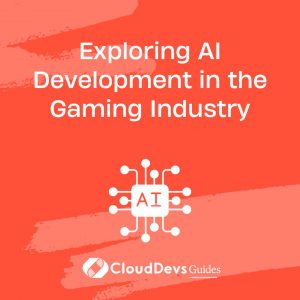Exploring AI Development in the Gaming Industry
In recent years, the intersection of artificial intelligence (AI) and the gaming industry has yielded remarkable innovations, transforming the way we experience and interact with virtual worlds. As technology continues to evolve, AI’s role in gaming has expanded beyond enhancing graphics and physics simulations, giving rise to smarter opponents, lifelike non-playable characters (NPCs), and procedurally generated content. This blog post delves into the exciting realm of AI development within the gaming industry, highlighting its impact on gameplay, character behavior, content creation, and more.
1. The Evolution of AI in Gaming
1.1. Early Encounters: Rule-Based Systems
In the early days of gaming, AI was rudimentary and often relied on rule-based systems. These systems employed predefined rules that governed NPC behavior, making them predictable and lacking in dynamic responses. For example, in a first-person shooter game, enemies might follow fixed paths and react in predefined ways to player actions.
python
if player_in_sight:
alert_nearby_enemies()
engage_player()
else:
patrol_around()
1.2. Emergence of Machine Learning
The gaming industry soon turned to machine learning techniques to imbue NPCs with a higher degree of intelligence. One prominent approach is reinforcement learning, where AI agents learn through trial and error to maximize rewards. OpenAI’s reinforcement learning algorithm, such as Proximal Policy Optimization (PPO), has enabled NPCs to adapt their strategies over time.
python
while not done:
action = agent.select_action(state)
next_state, reward, done = environment.step(action)
agent.update_policy(state, action, reward, next_state)
state = next_state
1.3. Advancing Realism: Neural Networks
Neural networks have revolutionized AI in gaming by enabling more nuanced decision-making. Games like “The Elder Scrolls V: Skyrim” utilize neural networks to create lifelike NPCs with human-like traits. Neural networks can analyze vast amounts of data to generate responses that mimic human cognition, making interactions with NPCs more immersive and unpredictable.
2. Reshaping Gameplay with AI
2.1. Dynamic and Adaptable Opponents
AI has breathed new life into single-player experiences by creating opponents that adapt to players’ actions. In games like “F.E.A.R.,” AI-controlled enemies learn from the player’s tactics and actively seek cover, flank, or retreat accordingly. This dynamic behavior keeps players engaged and forces them to strategize constantly.
python
def respond_to_player(player_actions):
if player_actions.aggressive:
take_cover()
flank_player()
elif player_actions.defensive:
coordinate_with_teammates()
suppress_player()
else:
retreat_and_regroup()
2.2. Collaborative and Competitive Multiplayer
Multiplayer games have also leveraged AI to enhance the experience. AI-controlled teammates can replace human players who drop out, ensuring a balanced match. Additionally, AI-driven bots can simulate a competitive environment, allowing players to practice and improve their skills before engaging with real opponents.
3. Bringing NPCs to Life
3.1. Natural Language Processing (NLP)
Incorporating natural language processing (NLP) into AI-driven NPCs allows for more natural and engaging conversations. Games like “Disco Elysium” utilize NLP to create branching dialogues that react to players’ choices, providing a personalized narrative experience.
python
def respond_to_player_input(player_input):
emotion = analyze_sentiment(player_input)
if emotion == "positive":
respond_with_encouragement()
elif emotion == "negative":
empathize_and_offer_help()
else:
steer_towards_neutral_response()
3.2. Emotional Intelligence
Advancements in AI have enabled NPCs to exhibit emotional intelligence. Games like “Red Dead Redemption 2” feature NPCs with mood systems that influence their behavior and interactions. This results in a more authentic and immersive gaming world, where NPCs can express a range of emotions based on context.
4. Procedural Content Generation
4.1. Infinite Worlds through AI
Procedural content generation, driven by AI algorithms, has opened new frontiers in game design. Games like “Minecraft” utilize AI to generate vast, open worlds with diverse landscapes, ensuring endless exploration opportunities for players.
python
def generate_world(seed):
terrain = generate_terrain(seed)
populate_with_flora_and_fauna()
distribute_resources_and_structures()
return terrain
4.2. Customization and Diversity
AI-driven procedural generation extends beyond landscapes. Games like “No Man’s Sky” employ AI to create diverse creatures, flora, and even entire planets. This not only reduces development time but also offers players a unique experience in every playthrough.
5. The Road Ahead
The convergence of AI and gaming is a journey of constant innovation. As hardware becomes more powerful and AI algorithms more sophisticated, we can anticipate even more astonishing developments. The application of AI in gaming is no longer limited to enhancing graphics or physics; it’s now an integral part of gameplay, creating immersive, dynamic worlds that respond intelligently to players’ actions.
From dynamic opponents that evolve with our strategies to NPCs that understand and respond to our words, AI’s impact on the gaming industry is profound. As procedural content generation continues to push the boundaries of creativity and customization, players can look forward to a future where each gaming experience is as unique as the individual playing it.
So, whether you’re marveling at the lifelike NPCs in the latest RPG or exploring procedurally generated galaxies, remember that AI is the driving force behind these innovations, forever changing the way we play and experience games. The future of gaming has arrived, and it’s powered by artificial intelligence.
Conclusion
In conclusion, the journey of AI in the gaming industry has been a remarkable one, evolving from rule-based systems to sophisticated neural networks and machine learning techniques. This evolution has reshaped gameplay dynamics, brought NPCs to life with emotional intelligence, and propelled procedural content generation to new heights. The gaming industry’s embrace of AI continues to redefine what’s possible, promising a future of endless creativity and immersion for players around the world. As we stand at the intersection of technology and entertainment, one thing is clear: the collaboration between AI and gaming is an adventure with limitless horizons.
Table of Contents









